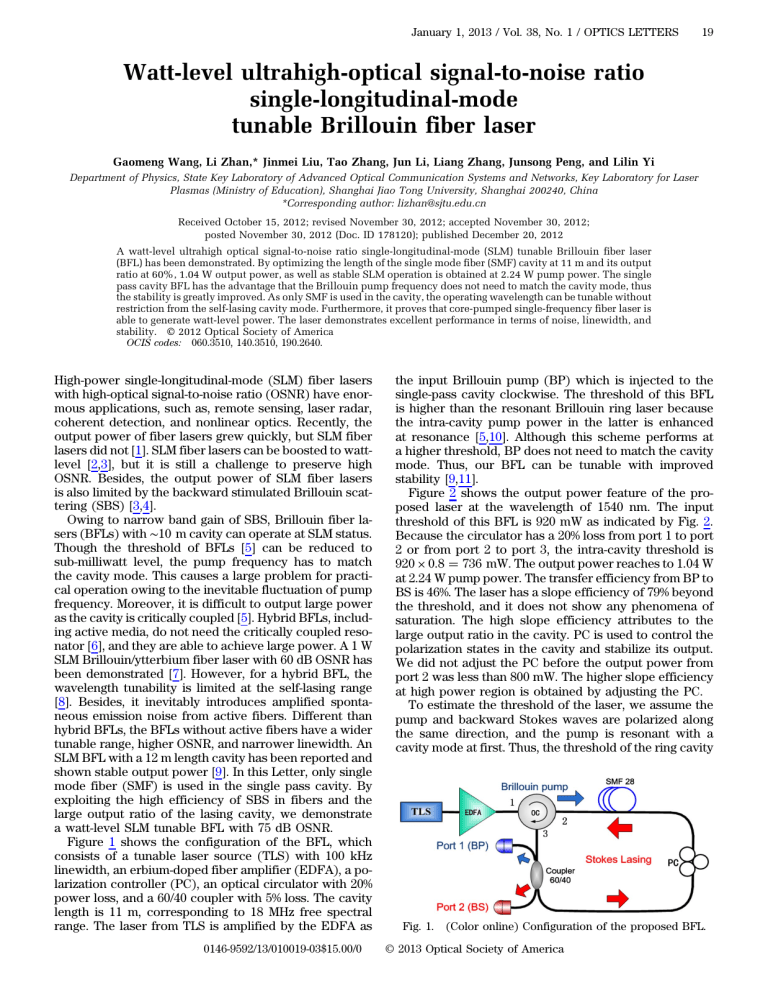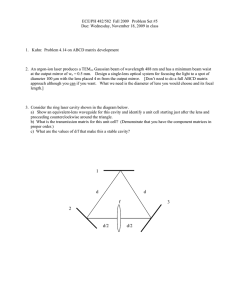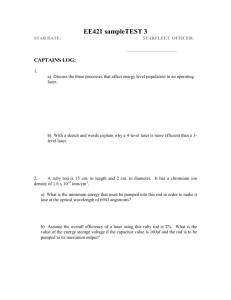Watt-level ultrahigh-optical signal-to-noise ratio single

January 1, 2013 / Vol. 38, No. 1 / OPTICS LETTERS 19
Watt-level ultrahigh-optical signal-to-noise ratio single-longitudinal-mode tunable Brillouin fiber laser
Gaomeng Wang, Li Zhan,* Jinmei Liu, Tao Zhang, Jun Li, Liang Zhang, Junsong Peng, and Lilin Yi
Department of Physics, State Key Laboratory of Advanced Optical Communication Systems and Networks, Key Laboratory for Laser
Plasmas (Ministry of Education), Shanghai Jiao Tong University, Shanghai 200240, China
*Corresponding author: lizhan@sjtu.edu.cn
Received October 15, 2012; revised November 30, 2012; accepted November 30, 2012; posted November 30, 2012 (Doc. ID 178120); published December 20, 2012
A watt-level ultrahigh optical signal-to-noise ratio single-longitudinal-mode (SLM) tunable Brillouin fiber laser
(BFL) has been demonstrated. By optimizing the length of the single mode fiber (SMF) cavity at 11 m and its output ratio at 60%, 1.04 W output power, as well as stable SLM operation is obtained at 2.24 W pump power. The single pass cavity BFL has the advantage that the Brillouin pump frequency does not need to match the cavity mode, thus the stability is greatly improved. As only SMF is used in the cavity, the operating wavelength can be tunable without restriction from the self-lasing cavity mode. Furthermore, it proves that core-pumped single-frequency fiber laser is able to generate watt-level power. The laser demonstrates excellent performance in terms of noise, linewidth, and stability. © 2012 Optical Society of America
OCIS codes: 060.3510, 140.3510, 190.2640.
High-power single-longitudinal-mode (SLM) fiber lasers with high-optical signal-to-noise ratio (OSNR) have enormous applications, such as, remote sensing, laser radar, coherent detection, and nonlinear optics. Recently, the output power of fiber lasers grew quickly, but SLM fiber
lasers did not [ 1 ]. SLM fiber lasers can be boosted to watt-
level [
2 , 3 ], but it is still a challenge to preserve high
OSNR. Besides, the output power of SLM fiber lasers is also limited by the backward stimulated Brillouin scattering (SBS) [
,
].
Owing to narrow band gain of SBS, Brillouin fiber lasers (BFLs) with
∼ 10 m cavity can operate at SLM status.
Though the threshold of BFLs [
] can be reduced to sub-milliwatt level, the pump frequency has to match the cavity mode. This causes a large problem for practical operation owing to the inevitable fluctuation of pump frequency. Moreover, it is difficult to output large power as the cavity is critically coupled [
]. Hybrid BFLs, including active media, do not need the critically coupled reso-
nator [ 6 ], and they are able to achieve large power. A 1 W
SLM Brillouin/ytterbium fiber laser with 60 dB OSNR has
been demonstrated [ 7 ]. However, for a hybrid BFL, the
wavelength tunability is limited at the self-lasing range
[
]. Besides, it inevitably introduces amplified spontaneous emission noise from active fibers. Different than hybrid BFLs, the BFLs without active fibers have a wider tunable range, higher OSNR, and narrower linewidth. An
SLM BFL with a 12 m length cavity has been reported and
shown stable output power [ 9 ]. In this Letter, only single
mode fiber (SMF) is used in the single pass cavity. By exploiting the high efficiency of SBS in fibers and the large output ratio of the lasing cavity, we demonstrate a watt-level SLM tunable BFL with 75 dB OSNR.
Figure
shows the configuration of the BFL, which consists of a tunable laser source (TLS) with 100 kHz linewidth, an erbium-doped fiber amplifier (EDFA), a polarization controller (PC), an optical circulator with 20% power loss, and a 60/40 coupler with 5% loss. The cavity length is 11 m, corresponding to 18 MHz free spectral range. The laser from TLS is amplified by the EDFA as
0146-9592/13/010019-03$15.00/0 the input Brillouin pump (BP) which is injected to the single-pass cavity clockwise. The threshold of this BFL is higher than the resonant Brillouin ring laser because the intra-cavity pump power in the latter is enhanced
at resonance [ 5 , 10 ]. Although this scheme performs at
a higher threshold, BP does not need to match the cavity mode. Thus, our BFL can be tunable with improved stability [
].
Figure
shows the output power feature of the proposed laser at the wavelength of 1540 nm. The input threshold of this BFL is 920 mW as indicated by Fig.
at high power region is obtained by adjusting the PC.
Fig. 1.
(Color online) Configuration of the proposed BFL.
© 2013 Optical Society of America
Because the circulator has a 20% loss from port 1 to port
2 or from port 2 to port 3, the intra-cavity threshold is
920
×
0
.
8 736 mW. The output power reaches to 1.04 W at 2.24 W pump power. The transfer efficiency from BP to
BS is 46%. The laser has a slope efficiency of 79% beyond the threshold, and it does not show any phenomena of saturation. The high slope efficiency attributes to the large output ratio in the cavity. PC is used to control the polarization states in the cavity and stabilize its output.
We did not adjust the PC before the output power from port 2 was less than 800 mW. The higher slope efficiency
To estimate the threshold of the laser, we assume the pump and backward Stokes waves are polarized along the same direction, and the pump is resonant with a cavity mode at first. Thus, the threshold of the ring cavity
.
20 OPTICS LETTERS / Vol. 38, No. 1 / January 1, 2013
1000
800
600
400
-60
(a)
-70
10.737 GHz
-70
(b)
-80 linewidth=6 kHz
-80 -90
-100
-90
-110
-100
10720 10730 10740 10750 10760
Frequency (MHz)
10736.56
10736.60
10736.64
10736.68
Frequency (MHz)
Fig. 4.
(Color online) Beating signal with (a) 50 MHz and (b)
200 kHz sweeping range.
200
0
0 300 600 900 1200 1500
Pump power (mW)
1800 2100 2400
Fig. 2.
(Color online) BFL output power as the function of pump power from EDFA.
P cr is given by
R m exp g
B
P where the peak Brillouin gain g
B fective mode area of fiber
A eff
∕ A eff
− α L 1
[
],
5
×
10 − 11 constant
α 0
.
0461 ∕ km, the fraction of Stokes power fed back after each trip
R m
≈ cr
0
L eff
.
4
,
85 μ m
2
L and m
∕ w, the ef-
, the attenuation
L eff are the fiber length and effective fiber length,
L 11 m. It should be noted that the circulator has 20% loss, and the intra-cavity
BP is the needed threshold of the proposed laser. The introduced loss by the circulator causes
R
R m
0
.
32
. So, we obtain
P the intra-cavity power put power
P input by
1 − γ loss of the coupler, κ r coupling coefficient.
T
P
1 − γ m intra
0 cr e − 2 α L
≃ 176
.
1 mW. At resonance,
[
∕ 1 − κ
0 m
0
.
8
×
0 r
, where,
γ
T m e − 2 α L
0
0
.
05 is the is the resonant is the power transmission for a ring resonator, and it is 80% here because the fiber loss can be neglected. Thus, we can deduce that
P intra
≃ 4
.
0 P input
, and the threshold in the single pass cavity should be 704.4 mW. Hence, we can conclude the experimental value of threshold (736 mW) is on a reasonable range. Still, we did not consider whether the peak of
Brillouin gain completely overlaps with the cavity mode
[
11 ] and the polarization effect [ 13
].
Figure
shows the output spectra from port 1 and port
2. The OSNR of the BFL is up to 75 dB, which is much higher than those of the hybrid BFLs [
OSNR is obtained due to the counter propagate, inten-
sity, and noise reduction of the SBS [ 14 ]. The frequency
shift is 0.088 nm at 0.015 nm resolution. We believe that it is hard to obtain such high OSNR in other types of wattlevel SLM fiber lasers.
Because short cavity is adopted [
], the SBS gain profile provides enough discrimination to make the laser work on the SLM operation. The estimated linewidth of this BFL should be several kilo-hertz [
large output power of this BFL, there is another good way to measure its linewidth [
16 ]. The laser could be used as
BP to generate the next order of Stokes in another fiber cavity, and then beat them together to generate the beating signal. The width of the beating signal should be wider than the linewidth of BS.
In Fig.
the observed beating frequency is
10.737 GHz when the BP is at 1560 nm, and its linewidth is 6 kHz as indicated by Fig.
effect of Stokes lasing, the second order of Stokes should be much narrower than the first one since a 10/90 coupler is used in the second cavity [
17 ]. So the linewidth of this
BFL should be less than 6 kHz. In the 50 MHz sweeping range in Fig.
, only one line exists, even at 1 W output power. It indicates that the SLM operation is achieved at all times. No mode hopping is observed because the cavity is so short that only one cavity mode could exist in the
20 MHz Brillouin gain spectrum.
For a laser, the broadband tunability will largely expand its practical value. Figure
shows that the laser can be continually tuned in the range from 1540 to
1570 nm by adjusting the wavelength of TLS, because no gain fiber is used in the cavity. The operating range is only limited by the gain bandwidth of EDFA. The power stability at 1 W output is measured in 2 h at the wavelength of 1540 nm. As shown in Fig.
power fluctuation is below 4%. The stable operation is a
coincidence with the experimental result in [ 9 ]. Due to
the short cavity, only one cavity mode could exist in the narrow Brillouin gain spectrum. The large resonator loss (60% output ratio) also helps the SLM lasing in the
20 MHz Brillouin gain band as other cavity modes cannot
Fig. 3.
(Color online) Spectrum of BP and BS.
30
(a)
15
0
-15
-30
-45
-60
-75
1530 1540 1550 1560 1570
Wavelength (nm)
1580
1200 (b)
1000
800
600
400
200
0
0 20 40 60 80
Time (minutes)
100 120
Fig. 5.
(Color online) (a) Tunability of the proposed BFL;
(b) Power fluctuation in 2 h at 1 W output power.
obtain net gain. Consequently, a stable SLM BFL with 1 W output power is achieved in the single pass SMF cavity.
Obviously, our method to generate watt-level SLM fiber laser is economical and easy to operate. Moreover, it changes the usual view that it is impossible for a corepumped single frequency fiber laser to generate watt-
level output power [ 2 ]. Here, the short cavity of 11 m
not only ensures the SLM operation, but also prevents the saturation effect from realizing high-power laser
output [ 3 ]. Certainly, the laser would have lower thresh-
old and more stable output if it was using polarization-
]. Not only can such a laser have practical application in many fields, it can also provide an excellent technological platform to study superlum-
] and optical generation of microwave frequency [
In conclusion, a watt-level ultrahigh-OSNR SLM tunable BFL is demonstrated. Because of the high efficiency of SBS in SMF and large output ratio of the cavity, the output power reaches 1.04 W at 2.24 W pump power.
At the same time, SLM operation is achieved. Ultra-high
OSNR (75 dB) is obtained, which is an outstanding feature of proposed laser. Different from the hybrid BFL, this laser has a broadband continually tunable range from 1540 to 1570 nm and ultrahigh OSNR. The measured linewidth is less than 6 kHz.
The authors thank J. K. Jang and S. G. Murdoch for helpful discussions and T. E. Murphy for helpful comments. This work is supported by the National Natural
Science Foundation of China (NSFC) under grants
61178014 and 11274231, and the key project of the Ministry of Education of China under grant 109061.
January 1, 2013 / Vol. 38, No. 1 / OPTICS LETTERS 21
References
1. D. J. Richardson, J. Nilsson, and W. A. Clarkson, J. Opt. Soc.
Am B 27 , B63 (2010).
2. T. Qiu, S. Suzuki, A. Schülzgen, L. Li, A. Polynkin, V.
Temyanko, J. V. Moloney, and N. Peyghambarian, Opt. Lett.
30 , 2748 (2005).
3. L. Xing, L. Zhan, S. Y. Luo, and Y. X. Xia, IEEE J. Quantum
Electron.
44 , 1133 (2008).
4. V. I. Kovalev and R. G. Harrison, Opt. Lett.
31 , 161 (2006).
5. L. F. Stokes, M. Chodorow, and H. J. Shaw, Opt. Lett.
7 , 509
(1982).
6. G. J. Cowle and D. Y. Stepanov, Opt. Lett.
21 , 1250 (1996).
7. W. Guan and J. R. Marciante, Opt. Lett.
34 , 3131 (2009).
8. Y. J. Song, L. Zhan, S. Hu, Q. H. Ye, and Y. X. Xia, IEEE
Photon. Technol. Lett.
16 , 2015 (2004).
9. S. Randoux, V. Lecoeuche, B. Segard, and J. Zemmouri,
Phys. Rev. A 51 , R4345 (1995).
10. L. F. Stokes, M. Chodorow, and H. J. Shaw, Opt. Lett.
7 , 288
(1982).
11. J. K. Jang and S. G. Murdoch, Opt. Lett.
37 , 1256 (2012).
12. G. P. Agarwal, Nonlinear Fiber Optics (Academic, 1995).
13. M. O. Van Deventer and A. J. Boot, J. Lightwave Technol.
12 , 585 (1994).
14. L. Stepien, S. Randoux, and J. Zemmouri, J. Opt. Soc. Am.
B 19 , 1055 (2002).
15. Z. Wu, L. Zhan, Q. Shen, J. Liu, X. Hu, and P. Xiao, Opt. Lett.
36 , 3837 (2011).
16. F. Mihelic, D. Bacquet, J. Zemmouri, and P. Szriftgiser, Opt.
Lett.
35 , 432 (2010).
17. A. Debut, S. Randoux, and J. Zemmouri, J. Opt. Soc. Am.
B 18 , 556 (2001).
18. L. Zhang, L. Zhan, K. Qian, J. M. Liu, Q. S. Shen, X. Hu, and
S. Y. Luo, Phys. Rev. Lett.
107 , 093903 (2011).
19. J. Liu, L. Zhan, P. Xiao, Q. Shen, G. Wang, Z. Wu, X. Liu, and
L. Zhang, IEEE Photon. Technol. Lett.
24 , 22 (2012).



